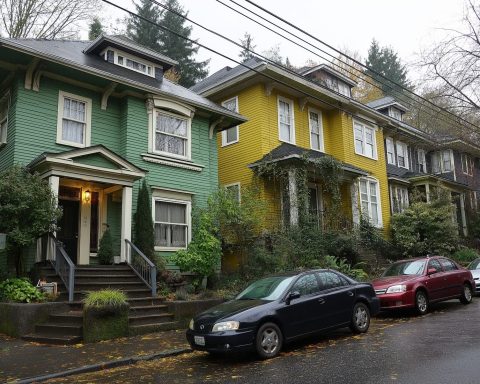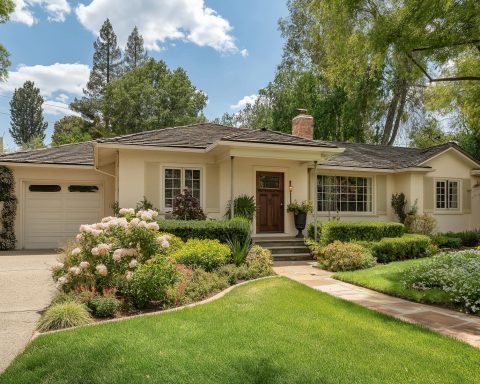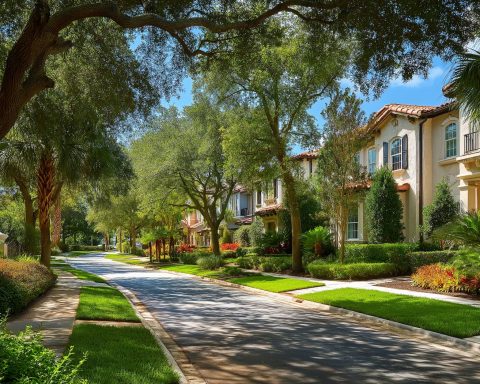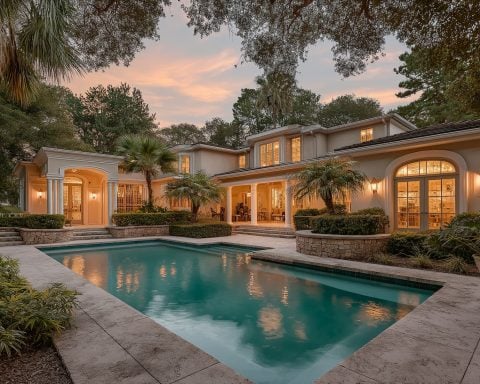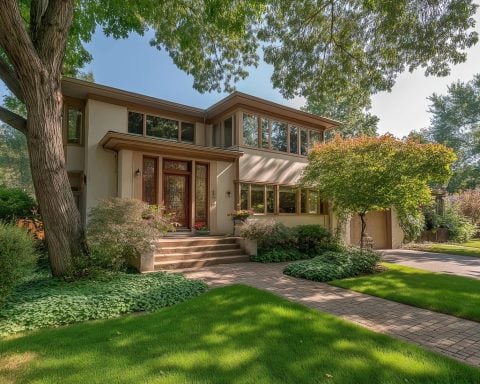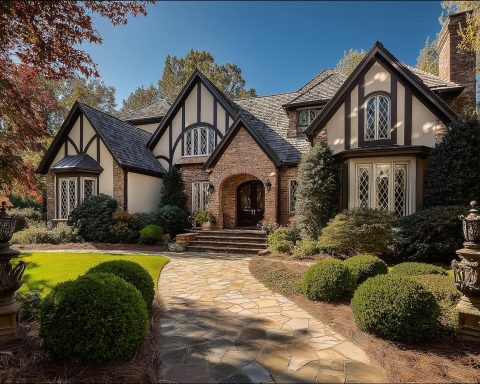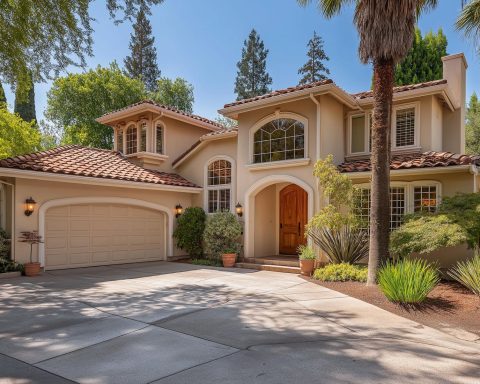Detroit’s real estate market is rebounding in 2025 with a mix of optimism and caution. After years of post-bankruptcy revitalization, residential prices are climbing and nearly all city neighborhoods are seeing gains detroitmi.gov. At the same time, ambitious commercial projects are reshaping the skyline, from new skyscrapers to massive infrastructure upgrades. Investors are eyeing Detroit’s famously affordable properties for big returns, but risks—from economic dependence on the auto industry to pockets of persistent blight—still linger. This report dives deep into Detroit’s 2025 real estate trends and the outlook through 2028, covering housing and commercial markets, key developments, neighborhood hotspots, and the policies influencing the Motor City’s property landscape.
Residential Real Estate Trends in 2025
Housing Market Overview
Detroit’s housing market in 2025 is defined by rising prices, limited supply, and resilient demand. After a frenzied post-pandemic surge, the market has settled into moderate growth. Home values have been increasing for nine consecutive years detroitmi.gov, reflecting a strong rebound from the city’s low point a decade ago. In fact, the city reports that 99% of Detroit neighborhoods saw home values increase in 2024 (206 out of 208 neighborhoods) detroitmi.gov – a remarkable breadth of appreciation that underscores the citywide nature of the recovery. These gains translated into roughly $1.4 billion in new homeowner wealth in 2024 alone detroitmi.gov.
By mid-2025, the typical Detroit home value stands around $80,000 zillow.com zillow.com – extremely affordable by national standards, yet essentially flat (a -0.2% change) from a year prior zillow.com zillow.com. The median listing price, however, has climbed into six figures: about $105,000 as of July 2025 zillow.com zillow.com. Homes are selling briskly, often within a month. The median Detroit home spends just 28 days on market before going pending zillow.com, a quick pace that signals many buyers are active despite higher interest rates. Indeed, 27% of sales have even closed above the list price zillow.com, indicating that turnkey homes in desirable areas can spark bidding wars. Overall, while Detroit remains a buyer-friendly market in terms of price level, the competition for quality move-in-ready homes is heating up.
Home Prices and Sales
Home price trends in Detroit show double-digit annual growth in many areas. For example, as of early 2024 Detroit’s median listing price was up 13.7% year-over-year to around $85,300 steadily.com. By summer 2025 the median listing had risen further (into the ~$100k+ range), though median sale prices lag a bit lower (roughly $83,000 in mid-2025) zillow.com zillow.com, suggesting many sales are investor flips or discounted fixer-uppers. Even with recent growth, Detroit’s median home price remains under $100,000 ark7.com – a striking contrast to other U.S. metros (for context, homes in Michigan’s capital Lansing average nearly $390,000 ark7.com). This low price base is a key attraction for investors and first-time buyers, but it also reflects the neighborhood-by-neighborhood variability in Detroit’s market.
Sales volume has been constrained by limited inventory. As higher mortgage rates in 2023 kept some sellers on the sidelines, Detroit’s for-sale inventory in mid-2025 was just over 3,100 homes (in a city of ~640k people) zillow.com. That inventory is slowly improving – February 2024 saw a 12.4% jump in homes for sale month-over-month as more sellers entered the market steadily.com. Still, supply remains tight relative to demand from both occupants and out-of-state investors. Industry forecasts expect home sales to tick up in 2025 as mortgage rates ease slightly and pent-up demand is released citylivingdetroit.com citylivingdetroit.com. Meanwhile, home price appreciation is projected to continue at a modest pace. National experts forecast around a 2.6% average home price increase in 2025 citylivingdetroit.com, with annual appreciation hovering in the 3–5% range through 2029 realwealth.com realwealth.com. Detroit, as a relatively small and affordable Midwestern market, could outperform that national average – some affordable Heartland metros may exceed 5% yearly gains in the coming years realwealth.com. However, the era of 10%+ yearly jumps is likely over; price growth is moderating to a sustainable, inflation-aligned rate.
Rental & Multifamily Market Trends
Detroit’s multifamily rental sector is a bright spot, with high demand and tightening vacancies. Occupancy in metro Detroit’s apartment market hit 93.2% by end of 2024 and is projected to rise to about 93.8% by end of 2025 mmgrea.com mmgrea.com. This reflects an influx of renters prioritizing affordability – the strongest occupancy gains have been in the “workforce housing” segment (mid- and lower-tier rentals), which jumped nearly a full percentage point in 2024 to over 93% occupancy mmgrea.com mmgrea.com. Even the high-end luxury apartments, which saw a slight uptick in vacancy last year due to new deliveries, are expected to stabilize as the pipeline of new construction slows in 2025 mmgrea.com mmgrea.com.
Rent growth has been impressive. Detroit posted a 3.4% effective rent increase in 2024, one of the highest rent growth rates among the nation’s 50 largest apartment markets mmgrea.com. This was second only to San Jose and well above the national average, thanks in part to Detroit’s limited new supply and steady job growth mmgrea.com mmgrea.com. For 2025, rents are forecast to keep rising albeit at a normalizing pace – roughly 3.8% growth for the year mmgrea.com. Notably, Detroit’s rent gains were consistent quarter-to-quarter even as some Sun Belt markets saw rent declines; the metro’s prudent construction pipeline (just ~1,700 new units slated for 2025) has prevented oversupply mmgrea.com mmgrea.com. With mortgage rates high and many would-be buyers stuck renting, investor interest in Detroit’s multifamily properties remains strong. New apartment projects are concentrated in hotspots like downtown, Midtown, and certain suburbs, and they’re being absorbed quickly by renters seeking modern amenities. Overall, the strong rental market is underpinning Detroit’s residential recovery – ensuring cash flow for landlords and offering housing options for those not ready or able to buy.
Commercial Real Estate Trends in 2025
Office Market
Detroit’s office real estate is gradually finding its footing in 2025 after the pandemic shook the sector. The metro-wide office vacancy rate hovers around 20% as of mid-2025 cbre.com – elevated by historical standards, but showing signs of stabilization. In fact, Q1 and Q2 of 2025 both saw positive net absorption of office space (a combined 130,000+ sq. ft. absorbed in the first half of the year) cbre.com. This marked the second straight quarter of tenants on the upswing, a hopeful sign after several years of downsizing. Many companies are rightsizing and upgrading to quality space rather than abandoning Detroit. Class A offices, especially downtown, are outperforming lower-tier buildings – downtown Detroit’s Class A vacancy is several percentage points below the market average (estimated in the high teens vs. 20% overall) cbre.com. Landlords of top-tier towers have lured tenants with renovated space and incentives, even as older buildings in secondary areas struggle with higher vacancy.
Leasing activity, while not booming, is steady. About 1.4 million sq. ft. of office leases were signed in the first half of 2025, slightly above the five-year average pace cbre.com. Notably, over half of that leasing volume was in Class A properties cbre.com, and new lease signings (as opposed to renewals) dominated – suggesting some businesses are moving into Detroit or expanding rather than just renewing existing offices. Deal sizes have skewed mid-range (10,000–50,000 sq. ft. tenants made up 45% of activity) cbre.com, indicating growth of mid-sized firms and startups. Asking rents for offices have dipped slightly in 2025 amid the high vacancies, but remain about 1–2% higher than a year ago cbre.com. Overall, Detroit’s office outlook is one of cautious optimism: vacancy is high but leveling off, and any recovery will be slow. The flight-to-quality trend means newer or recently renovated buildings downtown (e.g. those owned by Bedrock and other major landlords) should continue to fill up, while aging suburban office parks may lag in the era of hybrid work.
Industrial and Logistics
If office is Detroit’s weak link, the industrial real estate sector is its powerhouse. The region’s industrial/warehouse vacancy was just 3.3% at the end of 2023 steadily.com and about 3.7% by Q2 2025 cushmanwakefield.com – exceptionally low vacancy indicating virtually full occupancy of warehouses and factories. Demand for industrial space in Metro Detroit has been robust, driven by logistics, distribution, and automotive-related users. E-commerce giants and suppliers have scooped up available warehouses, and Detroit’s manufacturing base (especially with the shift to electric vehicle production) is spurring needs for modern industrial facilities. Even with a wave of new speculative construction deliveries, vacancy only ticked up by a few tenths of a percent year-over-year cushmanwakefield.com, showing that new space is quickly absorbed. Developers added roughly 500,000 sq. ft. of industrial space in late 2023–2024 and another 1–2 million sq. ft. is under construction in 2025, often in key logistics corridors.
Rents for industrial properties have been rising given the tight market. Many companies are willing to pay a premium for sites near transportation nodes like interstates and border crossings. Detroit’s status as a logistics hub will get another boost in late 2025 when the new Gordie Howe International Bridge to Canada is expected to open, enhancing cross-border trade flow. With that $4.7 billion bridge project nearing completion (targeting a fall 2025 opening) clickondetroit.com en.wikipedia.org, warehousing and trucking firms anticipate greater demand in Southwest Detroit. In summary, industrial real estate is a landlord’s market in Detroit: low vacancies, stable growth in occupancy, and continuing expansion of logistics infrastructure all point to sustained strength. Barring a major economic downturn, this sector should remain a cornerstone of Detroit’s commercial real estate through 2028.
Retail and Mixed-Use
Detroit’s retail real estate is experiencing a cautious revival. Years of population decline had left many retail corridors under-served, but recent redevelopment initiatives are bolstering the retail outlook. Several mixed-use mega-projects are underway that are drawing retailers back into the city. For instance, Bedrock’s new Hudson’s site downtown, the District Detroit expansion near Little Caesars Arena, and the $3 billion New Center “Future of Health” development (see Key Developments section) are all advancing in 2025. These projects are even attracting marquee brands – Apple is reportedly coming back to downtown Detroit with a flagship store, lured by the foot traffic these developments promise institutionalpropertyadvisors.com.
Despite these high-profile projects, new retail construction remains limited. High construction costs and still-recovering retail demand are keeping 2025 retail completions to around 247,000 sq. ft. in the metro institutionalpropertyadvisors.com. This slow growth in supply, combined with store reopenings, has kept retail vacancy very low. In fact, multi-tenant retail vacancy fell below 3% in Detroit in 2024 and remains near historic lows in 2025 institutionalpropertyadvisors.com. Established shopping centers and retail strips are largely full, especially in suburbs. Demand is strongest for grocery stores, fitness centers, and restaurants – segments that are expanding to serve Detroit’s improving neighborhoods and suburbs institutionalpropertyadvisors.com. Suburban submarkets like Macomb County and Southfield report robust leasing by these tenants, while affluent areas such as the Grosse Pointes, North Oakland, and western Wayne County suburbs saw retail rents jump 5%+ last year amid low vacancy institutionalpropertyadvisors.com.
Within the city, downtown and Midtown retail is gradually coming back as residents and office workers return. New downtown entertainment venues and residential conversions are adding ground-floor retail opportunities. Neighborhood retail remains a tale of two cities: revitalizing areas (e.g. Corktown, West Village) are gaining cafes and shops, whereas some outer neighborhoods still lack basic retail due to sparse population. Overall, investor interest in Detroit retail is picking up for the first time in years, thanks to high yields and the sense that the worst is over. In 2024, Detroit saw $635 million of retail property investment sales – up 23% from 2023 – as national investors regained confidence in the market pacommercial.com. With tight supply and population finally stabilizing, Detroit’s retail sector presents a turnaround story, albeit one that will unfold gradually.
Key Developments and Infrastructure Projects
Major developments and infrastructure projects in Detroit are reshaping the city and underpinning real estate growth. Here are some of the key projects in 2025 driving the market:
- Hudson’s Site Skyscraper (Downtown): Detroit’s skyline is getting a new centerpiece on the former Hudson’s department store site. Bedrock’s towering mixed-use development – including offices, luxury residences, retail, and event space – topped out in late 2023 and is advancing toward opening. This high-profile project has already lured retailers like Apple and is expected to reinvigorate Woodward Avenue with shopping and entertainment institutionalpropertyadvisors.com. Once complete (expected 2024–2025), the Hudson’s tower will be among the tallest buildings in Detroit, symbolizing the city’s resurgence.
- District Detroit & University of Michigan Innovation Center: The District Detroit is a sweeping plan to develop or renovate 10 buildings around Downtown and Midtown (near Little Caesars Arena). After some delays in 2023 due to financing challenges for an office tower, the focus shifted to residential and education uses. In 2025, construction is starting on a 261-unit apartment building in District Detroit axios.com. Moreover, a new University of Michigan Center for Innovation (UMCI) broke ground in late 2023 within the District, spearheaded by developer Stephen Ross. This $250 million tech and research campus is slated to open by 2027 as a downtown extension of U-M outliermedia.org bridgemi.com. The District Detroit plan also includes a 290-room hotel next to the arena in a later phase axios.com. These projects will bring students, faculty, and new residents to the area, boosting demand for housing and services.
- Renaissance Center Overhaul: General Motors’ iconic Renaissance Center complex on the riverfront may see a dramatic transformation. In late 2024, GM and Bedrock proposed a $1.6 billion redevelopment to partially demolish and reconfigure the aging RenCen towers axios.com. The plan would convert some of the complex into residential units and hotel space, integrating it better with the downtown street grid. However, it hinges on $250 million in public funding and political support axios.com. If the public funding falters, GM has even floated complete demolition as an alternative axios.com – underscoring the need to rethink the massive 1970s-era fortress. In 2025, all eyes are on whether this project secures financing. A successful RenCen makeover would open up prime riverfront real estate and potentially add hundreds of apartments, giving a jolt to downtown’s property market.
- Michigan Central Station & Corktown Campus: Ford Motor Company’s restoration of the historic Michigan Central Station in Corktown reached a milestone in 2024, with the once-derelict train depot fully renovated and unveiled in grand fashion axios.com. The nearly $1 billion project transforms the station and surrounding buildings into an innovation hub focused on mobility and technology (with Ford, Google, and other partners involved). As of 2025, the station is expected to begin hosting offices, labs, and possibly retail, with plans being discussed for on-site dining, a hotel, and even a return of passenger rail service axios.com. This development has already supercharged Corktown’s real estate – property values in the area have jumped as startups and employees look to locate near Ford’s campus. Additional phases, including new construction around the station, will continue through 2025–2026, further cementing Corktown as one of Detroit’s hottest neighborhoods.
- Henry Ford “Future of Health” Campus (New Center): In Detroit’s New Center district just north of downtown, construction is underway on a $2.5–$3 billion healthcare and residential mega-project axios.com. Led by Henry Ford Health, Michigan State University, and the Detroit Pistons, the project includes a major hospital expansion, medical research facilities, new residential apartments, and retail. Spanning to 2029, the “Future of Health” campus is one of the largest investments in Detroit’s history. It will bring cutting-edge medical facilities and hundreds of new housing units to New Center, an area already seeing a revival. In the short term, this project is causing road closures and traffic adjustments axios.com, but long term it promises a boom in jobs and residents. Real estate around New Center and Midtown is already appreciating in anticipation.
- New Detroit City FC Stadium (Southwest): Detroit’s beloved professional soccer team, Detroit City FC, announced plans to build a new stadium on the site of the long-vacant former Southwest Detroit Hospital. The club acquired ~16 acres on the edge of Corktown/Southwest for a stadium expected to open by the 2027 season axios.com. As of 2025, the project is in community planning stages. It will go through Detroit’s Community Benefits Ordinance process – a series of public meetings to ensure the development benefits local residents axios.com. The planned stadium and ancillary developments (training facilities, possibly housing or retail) will further activate the Michigan Avenue corridor and could accelerate growth in nearby Hispanic-centric Southwest neighborhoods. Property investors are already eyeing nearby commercial buildings and land, expecting a halo effect from the stadium.
- Transportation Infrastructure – Gordie Howe Bridge & I-375 Removal: Two major infrastructure projects will impact real estate. The Gordie Howe International Bridge, a new Detroit-Windsor span, is nearing completion with a target opening in late 2025 clickondetroit.com en.wikipedia.org. This bridge will greatly expand cross-border freight capacity. The Delray neighborhood, where the bridge’s Detroit terminus is located, has seen land assembly for new customs plazas and truck routes. Industrial developers anticipate increased warehouse demand on both sides of the border once the bridge opens. Another transformative project is the planned conversion of the I-375 downtown freeway into a street-level boulevard. Set to begin in 2025, this project will remove a 1-mile freeway that isolated downtown from the east-side neighborhoods. By 2027, I-375’s removal will free up land and reconnect areas like Eastern Market and Greektown, potentially unlocking new parcels for mixed-use development. City officials expect significant new real estate investment along the future boulevard where the freeway trench once lay.
Each of these projects – whether vertical developments or infrastructure – is a vote of confidence in Detroit’s future. They bring construction jobs in the near term, and in the long term, they address the city’s gaps (be it modern retail, healthcare facilities, transit connections, or housing stock). For real estate stakeholders, these initiatives are expanding the opportunity map beyond the traditional Downtown/Midtown core, knitting together the city’s fabric, and creating nodes of growth that should drive property values upward in surrounding areas for years to come.
Economic Factors Impacting the Market
Multiple economic forces are shaping Detroit real estate in 2025, including employment trends, migration patterns, and the interest rate environment:
- Employment and Wages: Metro Detroit’s economy has been adding jobs steadily, though the pace moderated in 2024–2025. The Detroit metro area unemployment rate was around 4.5–5% in mid-2025 fred.stlouisfed.org, roughly on par with the national average. However, the City of Detroit itself still faces roughly 10% unemployment as of early 2025 ycharts.com – a legacy of skills gaps and fewer jobs in the neighborhoods. The good news is that unemployment in the city is down from double digits a few years ago, and major employers (automakers, health systems, finance/tech firms) are hiring. Job growth in healthcare, tech, and advanced manufacturing is helping diversify Detroit’s economy beyond autos ark7.com. For example, Ford’s tech hub and Google’s presence in Corktown, plus startups in mobility and fintech, are bringing more high-paying jobs into the city. Rising employment boosts housing demand, yet the persistence of lower labor force participation in Detroit means some communities haven’t felt the job gains. Wage growth has been solid, which, combined with Detroit’s low housing costs, actually makes the city one of the most affordable big markets relative to local incomes. On the flip side, if auto industry volatility strikes (e.g. supply chain issues or labor strikes), Detroit’s economy could wobble, impacting consumer confidence in homebuying. So far in 2025, the economic outlook is cautiously positive: Michigan’s GDP is growing modestly and Detroit’s consumer spending is healthy, which bodes well for real estate stability.
- Population and Migration: In a historic turn, Detroit’s population may finally be stabilizing after decades of decline. The U.S. Census Bureau’s latest estimates showed Detroit’s population grew about 1% from 2022 to 2024, reaching approximately 645,000 residents bridgedetroit.com. This was the second year in a row of population gain bridgedetroit.com, something Detroit has not seen in over 60 years. The increase (about +6,800 people year-over-year) is attributed to a revised counting method and genuine new migration into revitalized neighborhoods bridgedetroit.com bridgedetroit.com. Young professionals and families are moving into renovated homes and new apartments, offsetting natural population loss. Mayor Mike Duggan noted that pockets of the city like Morningside (East Side) and Marygrove (Northwest) have seen more homes occupied now than in years past, thanks to renovations and newcomers bridgedetroit.com. Detroit remains about 78% African American demographically, but the city has recently attracted more non-black residents, contributing to the slight uptick in population bridgedetroit.com. A stable or growing population is a game-changer for real estate: it means more buyers, more renters, and increased retail demand. It also boosts investor confidence since a shrinking city is a red flag for property values. However, Detroit’s metro area overall is growing slowly, and Michigan as a whole faces demographic challenges (aging population, low birth rates). A state report even warned Michigan’s population could decline by 700,000 in the next generation if trends don’t improve bridgedetroit.com. Detroit’s ability to sustain these early gains – by attracting immigrants, retaining college grads, and luring suburbanites downtown – will be crucial for long-term housing demand.
- Interest Rates and Financing: The surge in mortgage rates over the past two years has been a double-edged sword for Detroit’s real estate. On one hand, higher interest rates (hovering around 7% for a 30-year fixed in 2023–24) priced out some homebuyers and put downward pressure on home price growth. Sales volume in late 2023 dipped as many buyers couldn’t afford the higher monthly payments. On the other hand, Detroit’s ultra-low home prices blunt some effects of high rates – a $100,000 mortgage at 7% is still more affordable than a $500,000 mortgage at 5%. As 2025 progresses, experts project mortgage rates will gradually ease. The consensus among Fannie Mae, MBA, and other forecasters is that rates will dip slightly in 2024–2025 as the Federal Reserve relaxes monetary policy in response to lower inflation citylivingdetroit.com citylivingdetroit.com. Indeed, the Fed is widely expected to begin cutting its benchmark rate in 2024, which “could drop mortgage rates as well—at least slightly,” according to Morgan Stanley citylivingdetroit.com. Even a fall from ~7% to ~6% would spur additional homebuyer demand, especially among first-time buyers who have been waiting on the sidelines. Lower financing costs would also help commercial development penciling out – some stalled projects (like certain District Detroit buildings) blamed high interest rates for making their financing unworkable axios.com. Investors watching Detroit are also sensitive to interest rates, as higher cap rates (driven by higher borrowing costs) tempered some investment sales in 2023. If rates stabilize or decline into 2025–2026, Detroit could see an uptick in both home sales and real estate investment transactions, injecting fresh momentum into the market.
- Inflation and Construction Costs: The broader economic climate – especially inflation – feeds into Detroit’s real estate. Construction material and labor costs rose sharply in 2021–22, and while inflation has cooled by 2025, building in Detroit remains expensive relative to rents/prices. This has a chilling effect on new construction of affordable housing and spec homes; developers often cite that appraised values in some Detroit neighborhoods still don’t justify construction costs without subsidies. The city has mitigated this with tools like tax abatements (e.g. Neighborhood Enterprise Zones that reduce taxes in targeted areas) to make new builds feasible. High insurance costs and property taxes in Detroit also affect investors’ calculations (Detroit’s property tax rate is among the highest in Michigan, though actual taxes on a $80k home are not huge in dollar terms). In response, the city has floated policy changes – most notably a Land Value Tax reform that would cut taxes ~17% for homeowners and small businesses by taxing land at a higher rate than structures detroitmi.gov detroitmi.gov. As of 2025 this proposal has not been implemented (it required state legislation and a voter referendum, which stalled) detroitersfortaxjustice.com, but if revived and passed in coming years it could significantly improve the economic equation for renovating or building property in Detroit. In sum, the macroeconomic factors of inflation, rates, and costs are a mixed bag: they have constrained supply and kept some buyers out, but Detroit’s improving fundamentals and potential policy relief (like tax reform) are gradually counteracting those headwinds.
Neighborhood Spotlight: Rising Areas vs. Struggling Areas
Detroit is often described as a “city of neighborhoods,” and in 2025 the fortunes of those neighborhoods vary widely. Some districts are booming with development and price appreciation, while others continue to grapple with blight and exodus. Below are examples of up-and-coming neighborhoods to watch and areas that face ongoing challenges:
Up-and-Coming Neighborhoods to Watch
- Corktown & Southwest Detroit: Corktown, Detroit’s oldest neighborhood, is in the midst of a renaissance fueled by Ford’s Michigan Central Station campus and a surge of new eateries, lofts, and now a planned soccer stadium. It, along with adjacent Southwest Detroit (Mexicantown/Hubbard Farms area), offers a mix of historic housing and vacant land now being infilled. Experts pinpoint Corktown and Southwest as 2025–2026 standouts benefiting from major investments and a hip, historic vibe matchrealty.com. Home values here have jumped as young professionals and even suburban transplants move in, drawn by the authentic urban feel and prospects of future growth (like the DCFC stadium and new transit connections). Hubbard Farms, for instance, a sub-neighborhood in Southwest, has beautiful early-1900s homes and is seeing investors restore properties, betting on appreciation as the area improves ark7.com.
- New Center & North End: New Center, anchored by the Henry Ford hospital expansion and the state-of-the-art Pistons/medical school development, is quickly becoming a growth node. This momentum spills into the North End neighborhood just to its east, which is rich in historic homes and has seen an influx of rehab projects. Improved transit (the QLine streetcar now connects New Center to Midtown/downtown) and big employers have made the area attractive. Experts note New Center as “gaining traction” thanks to infrastructure upgrades and job growth matchrealty.com. Property investors are active in the North End, as well as neighboring Boston Edison (a grand historic district) and Virginia Park, where prices are still relatively low compared to Midtown but rising. The city recently repaved streets and improved lighting in these areas, further boosting their appeal.
- Midtown & Brush Park: Midtown has been a poster child for Detroit’s revival for over a decade, and it remains hot. It boasts stable demand from Wayne State University, major cultural institutions, and a growing professional class. Brush Park, on Midtown’s northern edge, has transformed from a landscape of ruins into a mix of restored Victorian mansions and sleek new condos ark7.com. Dozens of townhomes and mixed-use developments (including affordable units) have been completed or are underway in Brush Park, drawing young renters and buyers who want to be near downtown. With the new hockey arena and the forthcoming University of Michigan Innovation Center a short walk away, Brush Park’s trajectory is firmly upward. Median home prices in Midtown/Brush Park are among the highest in the city, and yet demand remains high – a testament to the area’s desirability.
- Jefferson-Chalmers & East Riverfront: On the far east side along the Detroit River, the Jefferson-Chalmers neighborhood has gained attention as an affordable waterfront community with historic homes. Young urban homesteaders have been renovating houses here, attracted by canals that lead to the river (it’s sometimes called Detroit’s “Little Venice”). While flooding issues have posed challenges, the city is investing in seawall improvements and a new stormwater mitigation project. Closer to downtown, the East Riverfront area (Rivertown) has seen upscale apartment buildings rise and the extension of the RiverWalk park system. As the riverfront is now almost fully connected by a biking/walking path (voted the nation’s best riverwalk), adjacent property values have climbed. New condos, retail pavilions, and even proposals for an aquarium and urban beach are making the riverfront an increasingly vibrant neighborhood. Real estate in these east-side river zones is on the upswing, though still more affordable than Midtown.
- Bagley & Fitzgerald (Northwest): Tucked in Northwest Detroit near the University of Detroit Mercy, Bagley and Fitzgerald are historic residential areas that have seen significant community redevelopment efforts. The city’s Fitzgerald Revitalization Project in the late 2010s cleared blight and created greenways, parks, and rehabilitated homes, setting the stage for renewal. Now, private developers and nonprofits are continuing to flip vacant houses in these neighborhoods. Bagley, especially the part along Livernois Avenue (“Avenue of Fashion”), offers solid 1920s brick homes that have become popular with middle-class buyers and even some investors turning them into quality rentals. This area is cited as an up-and-coming community where you can still find a deal and benefit from appreciation as commercial strips revive rondoinvestment.com. The Livernois corridor has new cafés, bakeries, and boutiques – signs of a neighborhood on the rise.
Other neighborhoods on the watch list include West Village/Islandview on the east side (historic district seeing influx of new residents and businesses), Northwest Detroit areas like Rosedale Park (already stable, now seeing price increases as buyers seek more space), and select suburban enclaves just outside the city (Ferndale, Hazel Park, etc., which border Detroit and draw those who want urban amenities with suburban services) matchrealty.com. The overarching trend is that areas with strong architectural bones or location advantages are experiencing a renaissance. Young homeowners, often aided by renovation mortgages or land bank purchases, are breathing life into these neighborhoods. In turn, as occupancy rises, crime tends to fall and retail follows, creating a virtuous cycle in pockets across Detroit.
Neighborhoods Facing Challenges
Detroit’s progress remains uneven, and some neighborhoods continue to struggle with declining population, disinvestment, and low property values. These typically are areas that haven’t yet attracted significant redevelopment interest or are very isolated from the city’s job centers. For instance, parts of the far East Side (beyond Jefferson-Chalmers) and sections of Detroit’s west side like Brightmoor still see more people moving out than in. These communities often have dozens of vacant lots or derelict houses on each block, the legacy of years of tax foreclosures and demolitions. While the Detroit Land Bank Authority has leveled thousands of abandoned homes (helping remove dangerous blight), the empty land can in some places create an almost rural feel that is hard to rebuild without large-scale plans.
Economically, some of these neighborhoods have median home sale prices under $50,000, with many properties only mortgageable through special programs or bought with cash by speculators. The city’s data showing 206 of 208 neighborhoods had rising values means two neighborhoods saw values drop in the past year detroitmi.gov – likely in these most distressed areas. Candidates might include enclave neighborhoods like Riverdale on the far west or segments of Osborn or Van Dyke/Harper on the east where few new buyers are moving in. In such areas, even though citywide trends are positive, residents who stay are concerned about continuing issues like crime, school quality, and appraisals coming in too low. Without a “catalyst” investment (such as a new employer, a master redevelopment, or inclusion in an incentive zone), these neighborhoods risk being left behind by Detroit’s broader revival.
There are efforts to turn the tide. The city has programs to bundle and market vacant land for redevelopment, hoping to entice builders to create infill housing or parks. Community organizations are active, and some small victories (e.g. a new grocery store opening in a long-neglected area) can make a big difference. But the reality is that Detroit remains a patchwork, and real estate is hyper-local. An up-and-coming block can be just a mile from another where home values are still slipping. Investors must do their homework neighborhood-by-neighborhood. The hope is that as the stronger areas expand and population loss reverses, the rising tide will lift more boats. For now, though, Detroit’s revitalization is incomplete – enormous opportunity coexists with enduring challenges, often in close proximity.
Investment Opportunities and Risks
Detroit’s real estate comeback has put it on the radar of investors worldwide. Opportunities in 2025 are significant – but so are the risks. Here’s a look at why some are bullish on Detroit and what cautions should be kept in mind:
Key Investment Opportunities:
- Affordable Entry Prices & High Yields: Detroit offers some of the lowest entry costs for real estate in any major U.S. city. The median home price in the city is still under $100K ark7.com, meaning even small investors can buy properties (often with cash) and build a portfolio. Paired with relatively strong rents, the rental yields (cap rates) in Detroit can be very attractive. A landlord can purchase a single-family home for, say, $80,000, rent it for $900/month, and achieve a double-digit annual yield – numbers unheard of in expensive coastal markets. This dynamic, of course, depends on selecting the right neighborhood and managing rehab costs, but the cash flow potential is a big draw. It’s no surprise that Detroit has been cited as one of the best markets for single-family rental returns, and turnkey rental companies have proliferated to serve out-of-state investors. Additionally, with home prices rising off a low base (up 122%+ over the past five years in Detroit by some measures) steadily.com steadily.com, investors see room for continued appreciation as the city recovers.
- Value-Add and Development Plays: There is ample opportunity for value-add investment – buying distressed or outdated properties and renovating them. Detroit’s housing stock is full of early 20th-century architecture: brick colonials, Victorian houses, Art Deco apartments. Many structures in prime areas have “good bones” but need significant rehab. Investors who can navigate construction in Detroit can create significant equity by restoring these properties. The city and state offer incentives like historic preservation tax credits, and financing like 203(k) rehab loans can assist owner-occupants in fixing up homes. On the commercial side, developers are converting old office buildings into lofts, turning factories into artist studios, and repurposing land for new uses. For example, creative developers have seen success with mixed-use properties – blending residential and commercial elements – to tap multiple income streams steadily.com. As downtown and Midtown have filled in, there’s also opportunity in secondary districts (like Milwaukee Junction, Corktown, etc.) to get in early before those areas fully mature.
- Macro Trends Favoring Detroit: Broader trends in remote work and migration could benefit Detroit. The pandemic proved some jobs can be done from anywhere, and Detroit’s low cost of living is a selling point. There’s anecdotal evidence of some remote workers relocating from pricier cities to Detroit to buy handsome homes at a fraction of the cost. Meanwhile, Detroit’s economy is diversifying beyond autos – growth in tech, health, and even niches like urban agriculture provide new anchors for the real estate market ark7.com. The city’s downtown has also become a more vibrant 24/7 environment than it was 15 years ago, which helps attract talent (and by extension, companies). If Detroit can continue improving public safety and schools, it may increasingly draw people who want an urban lifestyle without the high price tag of NYC, Chicago, or the coasts.
- Long-Term Infrastructure and Projects: Investors with a long view are betting on the transformative infrastructure and development projects described earlier. Buying land or buildings near these mega-projects (e.g. near the Gordie Howe Bridge, in the path of the I-375 boulevard plan, around New Center, etc.) could yield large payoffs once those projects come to fruition. Already, industrial land values on Detroit’s southwest side have risen anticipating the new bridge. In downtown, speculation abounds around sites like the soon-to-be removed I-375—developers are assembling parcels expecting a real estate boom when that area reconnects to downtown. Essentially, for those who believe in Detroit’s trajectory, now is the time to acquire assets while prices are still relatively low.
Key Investment Risks:
- Economic Dependence & Volatility: Detroit’s fortunes still rise and fall somewhat with the auto industry and manufacturing. A recession that hits auto sales or a major restructuring at one of the Big Three automakers could send shockwaves through Detroit’s economy. While the city is more diversified than before, a large share of metro jobs are still tied to automotive (directly or indirectly). There is also the looming question of the auto industry’s transition to electric vehicles and potential automation – which could reduce jobs over time. Investors must consider the risk of an economic downturn or sector disruption, which could weaken demand for both residential and commercial real estate. The unemployment rate in the city remains high ycharts.com, and poverty is still a challenge, meaning parts of the market are fragile and rely on government support (vouchers, etc.) to sustain rents.
- Property Tax and Insurance Burdens: Detroit has notoriously high property tax rates – the millage rate is roughly double that of the suburbs detroitmi.gov. Although actual tax bills are low on cheap properties, once you renovate and add value, taxes can jump and eat into profits (state law caps annual increases to inflation for owner-occupied homes, but investors don’t get that cap after they purchase). Efforts are underway to reform this via the Land Value Tax plan (which would cut taxes on structures by ~30% if implemented) detroitpbs.org detroitmi.gov, but as of 2025 that’s not in effect. Additionally, insurance in Detroit can be costly; the city’s high incidence of insurance claims (theft, fire, etc.) means premiums are above average. For example, some Detroit landlords pay insurance rates nearly double what a similar house would cost to insure in a suburb. These carrying costs can surprise investors and erode cash flow if not accounted for.
- Property Condition and Maintenance: Many Detroit properties, especially the most affordable ones, require significant rehabilitation. Buying a $50,000 house may also mean needing to invest $50,000 or more in repairs. Common issues include outdated or unsafe electrical and plumbing, roofs in need of replacement, lack of functional HVAC, and even structural problems due to long-term neglect. Investors who underestimate renovation costs or tenant turnover costs can run into trouble. There’s also the challenge of finding reliable contractors; demand for skilled labor is high with all the redevelopment happening, and costs can escalate or projects can face delays. Owning property in Detroit often isn’t “passive” – it demands active management. From ensuring vacant homes aren’t vandalized, to dealing with city permitting and inspections in rehabs, to screening tenants in a city with lower average credit scores, an investor must be diligent or hire a capable local property manager.
- Blight and Neighborhood Risk: The block-by-block nature of Detroit means an investor can buy on what seems like a decent block, only to find the surrounding few blocks deter quality tenants or buyers. If a property is one of only a handful of occupied homes in a sea of empties, the renter pool will be limited. Crime and safety are improving in Detroit but remain concerns in some neighborhoods – and perception matters. Some out-of-state investors learned hard lessons in the last decade buying super cheap houses sight-unseen, only to realize the area was not livable. Now, sophisticated investors target specific up-and-coming pockets rather than buying indiscriminately. Still, the risk of picking the “wrong” neighborhood is real. Until Detroit’s revival reaches all parts of the city, properties in weak-market areas may see minimal appreciation and could even decline in value after an initial speculative bump. Liquidity can be an issue too: it’s not always easy to resell a property in a struggling area, as there may be few willing buyers except at bargain prices.
- Regulatory and Compliance Risks: Detroit has been strengthening its enforcement of rental regulations. Landlords must register rentals and pass inspections (the city is gradually rolling this out ward by ward). Non-compliance can result in fines or even being unable to evict non-paying tenants (if the property isn’t a certified rental, judges can deny eviction requests). Additionally, new eviction diversion programs and tenant protections have emerged, meaning landlords need to follow proper legal procedures closely. While these are not insurmountable issues, they require investors to be informed and possibly engage legal help, adding to costs. On the development side, Detroit’s Community Benefits Ordinance (CBO) adds a layer for large projects (over $75 million): developers must negotiate community agreements for local hiring, noise mitigation, etc. axios.com. While this mainly affects big players, it’s indicative of a regulatory environment aiming to balance development with community interests. Investors should keep an eye on city policies – for instance, any changes to rental regulation, tax incentives, or zoning (Detroit is even experimenting with more permissive zoning for things like ADUs, which could be an opportunity for adding units to single-family lots) reddit.com.
In summary, Detroit offers a high-reward but higher-risk landscape. Many have found success buying low and riding the wave of the city’s recovery – turning dilapidated properties into profitable rentals or flipping homes for significant gains. The opportunity to be part of a true urban turnaround story is enticing. Yet, caution and local expertise are essential. The most successful investors in Detroit often partner with local teams, do extensive due diligence on neighborhoods, and have contingency budgets for the unpredictable. As Detroit’s narrative continues to improve, the hope is that some of the risks (blight, population loss, etc.) will recede, and the opportunities will further blossom. For now, anyone investing in the Motor City must keep their eyes open and their expectations realistic, balancing optimism with prudence.
Policy and Regulatory Changes
Government policy and regulations play a pivotal role in Detroit’s real estate environment. A few key recent and proposed changes are worth noting:
- Property Tax Reform (Proposed Land Value Tax): Detroit’s leaders recognize that the city’s property tax structure is a barrier to growth. In 2023, Mayor Mike Duggan proposed a bold Land Value Tax (LVT) plan that would cut property tax rates on buildings by about 30% and significantly increase taxes on land value detroitpbs.org detroitmi.gov. The idea is to relieve homeowners and productive property owners of the nation’s highest big-city tax burdens, while penalizing speculators who hold vacant land idle at very low tax cost. According to the proposal, 97% of Detroit homeowners would get a tax reduction (averaging 17% off their tax bill) if LVT is implemented detroitmi.gov detroitmi.gov. For example, the owner of a $100,000 house might save ~$900 per year detroitmi.gov. Meanwhile, the taxes on a typical vacant lot would nearly triple detroitmi.gov, pressuring landowners to develop or sell. The state legislature passed enabling legislation in late 2023 to allow Detroit to put this on the ballot house.mi.gov, but as of 2025 the initiative has stalled amid some opposition and political hurdles detroitersfortaxjustice.com. If eventually approved by voters, the LVT could take effect in coming years and would be the first overhaul of Detroit’s property tax in decades detroitpbs.org. Real estate stakeholders are watching this closely: it could spur development of thousands of vacant lots and significantly improve the financials of owning property in Detroit. On the other hand, opponents worry about potential unintended consequences (e.g. higher taxes on parking lots being passed on to consumers, etc.). For now, the status quo remains, but expect the tax discussion to resurface as Detroit seeks ways to sustain its momentum.
- Community Benefits Ordinance (CBO): Implemented a few years ago, Detroit’s CBO requires that any development project over $75 million (or receiving significant public subsidy) must undergo a community engagement process and negotiate benefits for the local neighborhood. This could include commitments to hire Detroit residents, invest in parks, fund workforce training, or other measures. The new DCFC soccer stadium, for instance, will go through this multi-meeting process in 2025 to address community concerns and needs axios.com. While developers initially balked at the CBO, it has now become part of doing business in Detroit. It adds some time and cost to large projects, but also tends to smooth community relations and can head off opposition. Smaller developers are not directly impacted by the CBO, but the spirit of it has led to more attention on development impacts even for mid-sized projects. The city has also created an Office of Community Benefits to oversee compliance. Overall, Detroit’s CBO is seen as a model by some other cities and represents a shift toward more inclusive development – an important consideration for real estate investors who plan big projects.
- Zoning and Land Use Flexibility: Detroit has been updating its zoning code to encourage adaptive reuse and new housing typologies. For example, changes in recent years made it easier to build Accessory Dwelling Units (ADUs) in certain neighborhoods (like carriage houses or basement apartments on single-family lots) reddit.com. The city is also more open to “missing middle” housing – such as duplexes or fourplexes – in areas once zoned exclusively for single families, in order to increase density and housing options. In commercial areas, outdated use restrictions have been relaxed to allow things like live-work spaces, micro-retail, and pop-up businesses. These reforms are gradual but ongoing, aimed at reducing red tape for development. As Detroit tries to repopulate, expect further zoning innovations, perhaps density bonuses for affordable housing, or streamlined approvals in designated growth zones. Real estate developers who stay attuned to these changes can capitalize on new opportunities (for instance, adding an ADU for rental income or converting an old industrial building to mixed commercial use without needing as many variances).
- Rental Regulations and Tenant Protections: With a large renter population, Detroit has put some focus on housing stability. Programs like right to counsel for low-income tenants facing eviction have been introduced, and there’s discussion of “just cause” eviction ordinances, though nothing passed city council as of 2025. Landlords are required to register their rentals and get them inspected/certified – an effort Detroit ramped up since 2018. By 2025, many neighborhoods have been through at least one cycle of inspections, and the city continues to roll this out until all rental properties are compliant. This is ultimately positive for housing quality, but in the short term it forced some “DIY” landlords to invest in repairs or sell properties rather than face fines. Additionally, the city recently created a rental property database and is exploring ways to curb speculative evictions and excessive rent hikes in subsidized housing. While Detroit hasn’t enacted rent control (and can’t under state law), these softer measures indicate a more pro-tenant stance. Investors in the rental market need to be aware of the compliance requirements and the likelihood of increased scrutiny on housing conditions.
- State and Federal Incentives: On a higher level, Michigan has various incentive programs that impact Detroit real estate. “Opportunity Zones” created by the 2017 federal tax law include many Detroit neighborhoods, giving investors tax benefits for investing in projects there (the OZ program runs through 2026, and many Detroit projects have utilized it). The state also revived historic tax credits, which several Detroit developers have used to restore old buildings downtown and in neighborhoods. Additionally, programs like the Low-Income Housing Tax Credit (LIHTC) and Michigan’s housing development fund are actively being used to build affordable housing in Detroit, often as part of mixed-income developments. These policies help fill financing gaps and encourage development that might not happen purely with private capital. A keen investor or developer can stack such incentives to make a Detroit project viable and profitable. For example, a new mixed-use building might use a property tax abatement, an Opportunity Zone investment, and grants for environmental cleanup if it’s a brownfield site. Navigating these incentives can be complex, but Detroit’s public-private ecosystem has gotten more sophisticated in recent years to guide developers through it.
In essence, Detroit’s policy landscape is moving in a direction to support continued real estate growth while trying to ensure inclusion. Lowering tax burdens on homeowners, demanding community input on big projects, easing zoning to allow creative development, and protecting renters are all pieces of the puzzle to make Detroit’s revival sustainable. Stakeholders should keep a close watch on City Hall and Lansing (state government) for policy shifts, as these can significantly alter the investment calculus. If Detroit succeeds in implementing tax cuts and attracting more residents, the regulatory environment will have played a big part in turning the city into a more investment-friendly and livable market.
Conclusion
In 2025, Detroit’s real estate market stands at a pivotal crossroads between a storied past and a hopeful future. Residential neighborhoods once written off are buzzing with renovation crews and new residents, driving up home prices yet still remaining remarkably affordable compared to national norms. Commercial corridors are coming alive with shops and eateries as massive projects reshape the city’s core and beyond. The Motor City’s economic engine is diversifying and gaining horsepower, which bodes well for housing demand and property values in the coming years. Forecasts through 2028 predict steady, if moderate, growth – no boom, no bust, just a city steadily rebuilding its foundation realwealth.com realwealth.com.
Challenges persist, of course. Pockets of Detroit still grapple with blight, and investors must balance the promise of high returns with the perils of urban revitalization. Yet the overall trajectory is encouraging: policies are targeting long-standing obstacles, population decline appears to be reversing, and there is a palpable sense of momentum. As one local demographer put it, “we can call it a trend” that Detroit is growing again bridgedetroit.com, a trend expected to “continue and get stronger in the years to come” bridgedetroit.com.
For those considering Detroit, 2025 is a time to watch closely or jump in – the city is arguably at its most dynamic point in decades. Whether it’s the draw of a downtown condo in a rehabilitated skyscraper, a fixer-upper in an up-and-coming district, or a stake in a commercial redevelopment, Detroit offers a real estate landscape rich with possibility. The Motor City’s comeback story is still being written, and the next chapters through 2028 look to feature continued revitalization, new skyline-defining projects, and the steady knitting together of a more vibrant, diverse urban fabric. In real estate – as in its legendary auto industry – Detroit is proving that it can innovate, adapt, and drive forward, making it one of the nation’s most intriguing property markets to watch.
Sources: Detroit real estate market data and trends zillow.com detroitmi.gov; Metro Detroit commercial market reports cbre.com institutionalpropertyadvisors.com; City of Detroit housing and population reports detroitmi.gov bridgedetroit.com; expert forecasts and analyses realwealth.com matchrealty.com; local news on developments and policy changes axios.com detroitmi.gov.



